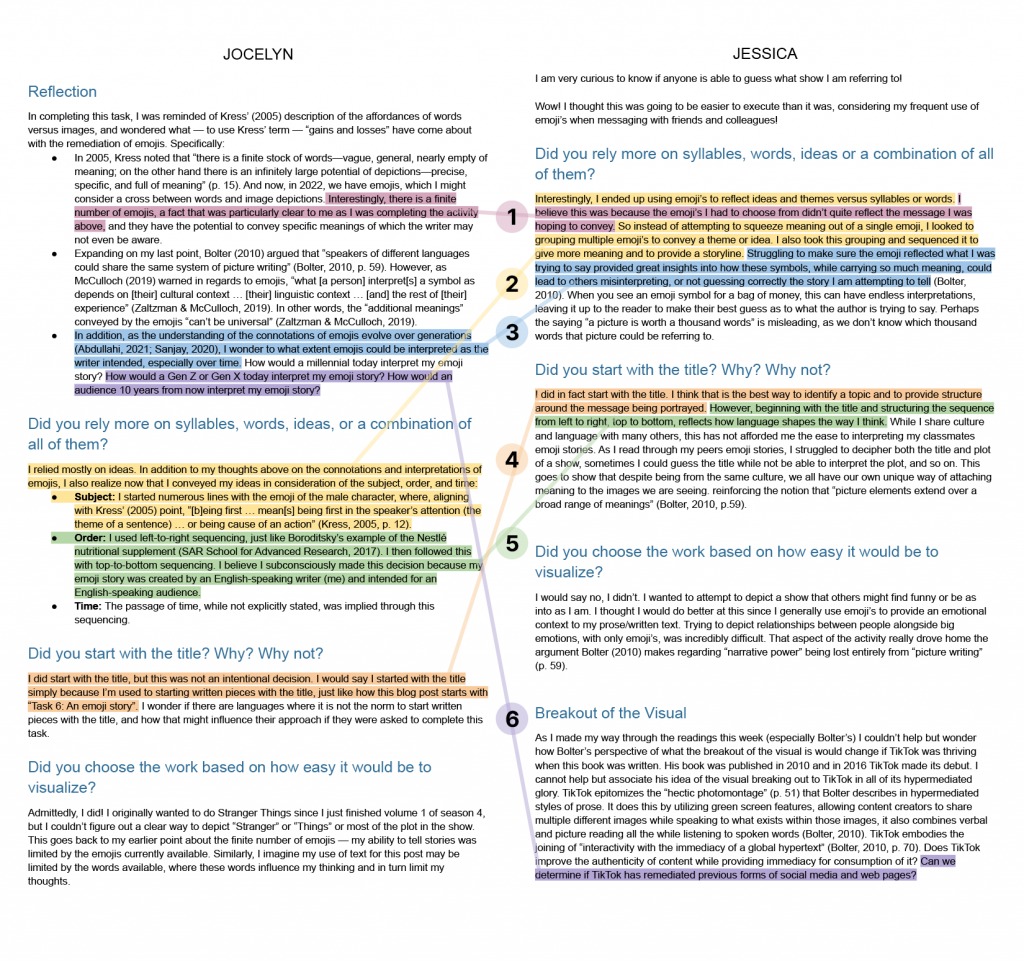Links: My post for Task 7 · Sophy’s post for Task 7
I chose to link to Sophy’s post because she leveraged the audio form to share her experience of culture, which I think is a really clever way to tackle this task! I’ve been looking forward to linking to one of Sophy’s posts — I also really enjoyed her posts for Task 4 and Task 5, and her post for Task 7 is another one of my favourites.
I will skip the Xanadu-inspired linking for this post (which I’ve done for all of my other linking posts so far), since Sophy and I approached our tasks quite differently.
How has your colleague’s experience differed from yours? And how do you know?
-
- Our experiences: From what I’m gathering from Sophy’s soundscape, there are differences in how we experience culture on a daily basis. Listening to Sophy’s soundscape reminded me of a previous point in time for me — prior to the pandemic, I used to take transit everyday; I’ve since bought a car and also don’t have to leave home much. If I were to create a soundscape of a day-in-the-life three years ago, it would’ve sounded similar to Sophy’s, but if I were to create one now, it would primarily consist of clicking sounds from my keyboard and mouse, water boiling (for tea), and the quiet hum of my fridge.
- Our approaches for Task 7: Sophy and I each explored the sounds we hear related to our items, but whereas I described mine from a personal lens, Sophy described hers in the context of how she experiences culture, which I thought was brilliant and is what drew me to her post!
What web authoring tool have they chosen to manifest their work?
-
- For our blogs: We’re both using WordPress on UBC Blogs.
- For our posts for Task 7: We both primarily leveraged audio for the activity and shared our reflections using text.
How does their tool differ from yours in the ways in which it allows content-authoring and end-user interface?
I imagine the content-authoring capabilities for our sites are similar since we’re both using WordPress on UBC Blogs. However, we’re using different themes, which results in differences in interface:
-
- Navigation panel: Sophy’s theme, like Emily’s, uses a left navigation panel. Mine uses a right navigation.
- Profile image: The theme that Sophy is using has a placeholder for a profile image in the top left corner, and it looks like she used that space for an illustrated self-portrait. Sophy had referenced her interest and experience in art in her previous posts, and with that in mind I think the illustration works perfectly in welcoming the audience to her blog.
- Font: Sophy’s theme uses a serif font whereas mine uses sans-serif. At some point sans-serif fonts were recommended for computer screens but it seems like that is no longer necessarily the case (Nielsen, 2012). I personally like serif fonts more and really like how the serif font looks on Sophy’s blog.
- Tagging: I also noticed that Sophy tagged her posts, and as a reader I find the tags very helpful in providing an overview of the topics. I will definitely be considering adding tags to my posts.
What literacies does their site privilege or deny in comparison and contrast to yours?
I will leverage two key themes of The New London Group’s (1996) article A pedagogy of multiliteracies: Designing social future — cultural & linguistic diversity and modes — in exploring the literacies of our sites and posts.
Cultural & linguistic diversity
-
- Language (similarity): Sophy and I both use the English language for our posts. In addition, in her post for Task 4 Sophy mentioned she lived in Taipei last year, and a few years ago I had lived in Hong Kong for two years. I wonder what additional similarities are (perhaps subconsciously) afforded by our blogs, with both of us also having lived in cities that share the same primary written language.
- Appreciation for art (similarity): Both Sophy and I have referenced our appreciation for art in our previous posts, and I think this has surfaced in how we approached our tasks compared to some of our peers.
Modes
-
- Visual design (similarity): Similar to my theme, Sophy’s theme uses a narrow post layout, which means that a single sentence can easily span across multiple lines. I also noticed that Sophy and I both use relatively short sentences and paragraphs for our posts — I wonder if the way we’re writing our posts is influenced by the themes we chose.
What theoretical underpinnings are evident in your/your colleague’s textual architecture and how does this affect one’s experience of the work?
As I noted earlier, Sophy’s post explores her daily experience of culture. I especially like how she put it in explaining her decision to create a soundscape — a soundscape allows us to “catch a glimpse of an individual’s private life in this public space” (Chu, 2022). This suggests to me that she has a deep understanding and appreciation for her interaction with culture, and in turn would be able to make more conscious choices about her participation.
I also really enjoyed reading her thoughts on how public transit can be an analogy for “the boundaries between public and private” lifeworlds (Chu, 2022).
How do the constraints of the course design manifest in your architectural choices? How have you responded to the pedagogical underpinnings of this course design in your own web space?
Sophy’s point about the boundaries between the public and private helped me realize that the use of blogs for this course is also an interesting blur of the boundaries between assignments created for a course and for public consumption.
While the target audience of these posts is our peers and instructor for the course, they can technically be accessed by anyone with access to the web, and most of these posts do not require extensive context for someone who isn’t the target audience to consume. I also think that having our tasks in our individual blogs makes for a more cohesive body of work, as opposed to the one-off assignments for many other courses.
I will keep this thought in mind as I create my posts for upcoming tasks and see how I can better leverage this blur of the boundaries.
References
Chu, S. (2022, July 6). Task 7: Mode bending. ETEC540 – Text Technologies: The Changing Spaces of Reading and Writing. https://blogs.ubc.ca/etec540thc/2022/07/06/task-7-mode-bending/
Nielsen, J. (2012, July 1). Serif vs. sans-serif fonts for HD screens. Nielsen Norman Group. https://www.nngroup.com/articles/serif-vs-sans-serif-fonts-hd-screens/
The New London Group. (1996). A pedagogy of multiliteracies: Designing social futures. Harvard Educational Review, 66(1), 60-92. http://newarcproject.pbworks.com/f/Pedagogy%2Bof%2BMultiliteracies_New%2BLondon%2BGroup.pdf


